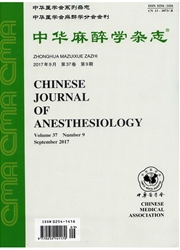

 中文摘要:
中文摘要:
目的评价海马α-氨基-3-羟基-5-甲基-4-异恶唑基丙酸(AMPA)受体在氯胺酮对大鼠抗抑郁效应中的作用。方法雄性Wistar大鼠30只,2月龄,体重180—220g,采用随机数字表法,将其随机均分为3组(n=10):对照组(C组)、氯胺酮组(K组)和AMPA受体拮抗剂NBQX组(N组)。行强迫游泳实验15min建立大鼠抑郁模型。于第2天N组腹腔注射NBQX10mg/kg;30min后C组腹腔注射生理盐水1.0ml,K组和N组腹腔注射氯胺酮10mg/kg。30min后再次进行强迫游泳试验5min,记录大鼠不动时间。然后处死大鼠,取海马组织,测定磷酸化雷帕霉素靶蛋白(p-mTOR)和磷酸化谷氨酸受体1(p-GluRl)的表达。结果与C组比较,K组不动时间缩短,海马roTOR和GluRl表达上调,N组不动时间缩短,海马mTOR表达上调,GluRl表达下调(P〈0.05);与K组比较,N组不动时间延长,海马mTOR和GluRl表达下调(P〈0.05)。结论海马AMPA受体参与了氯胺酮对大鼠的抗抑郁作用,可能与抑制mTOR和GluRl的活性有关。
 英文摘要:
英文摘要:
Objective To evaluate the role of hippocampal AMPA receptors in the antidepressant effect of ketamine in rats. Methods Thirty male Wistar rats aged 2 months weighing 180-220 g were randomly divided into 3 groups (n = 10 each): control group (group C); ketamine group (group K) and AMPA receptor antagonist NBQX group (group N). The animals were forced to swim for 15 min on the 1st day. On the 2nd day, NBQX 10 mg/kg was injected intraperitoneally in group N; 30 min later, normal saline was injected intraperitoneally in group C, while ketamine 10 mg/kg was injected intraperitoneally in groups K and N. The forced swimming test was performed again for 5 min at 30 min after administration and the immobility time of the rats was recorded. Then the animals were sacrificed and the hippocampus was removed for determination of the expression of phosphorylated rapamycin (p-roTOR) and phosphorylated glutamate receptor 1 (p-GluR1).Results Compared with group C, the immobility time was significantly shortened and the expression of p-mTOR and p-GluR1 up-regulated in group K, and the immobility time was significantly shortened, the expression of p-mTOR up-regulated and the expression of p-GluR1 down-regulated in group N (P 〈 0.05). Compared witfi group K, the immobility time was significantly prolonged and the expression of p-mTOR and p-GluR1 down-regulated in group N (P 〈 0.05). Conclusion AMPA receptors in hippocampus are involved in the antidepressant effect of ketamine in rats and the inhibition of roTOR and GluR1 activities may be involved in the mechanism.
 同期刊论文项目
同期刊论文项目
 同项目期刊论文
同项目期刊论文
 期刊信息
期刊信息
